My Lost Youth赏析
诗歌《我如行云独自流》英文分析
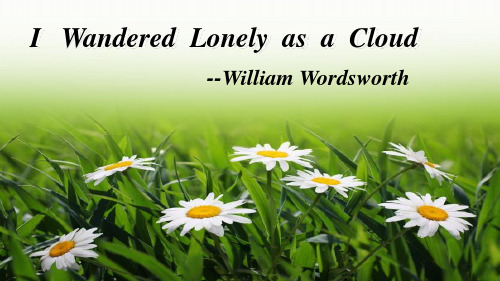
Influence
the leading figure of the English romantic poetry. contribution: he has not only started the modern poetry, the poetry of the growing inner self, but also changed the course of English poetry by using ordinary speech of the language and by advocating a return to nature.
波光里的涟漪也舞弄清影,却 怎比得水仙的欢快; 伴有这等喜悦, 诗人如何不快! 我——久久凝视——但毫无答复,
A poet could not but be gay,
In such a jocund company:
I gazed---and gazed---but little thought
What wealth the show to me had brought. 可知这景致给予我多少财富:
Lake poets
Wordsworth, Coleridge and Southey were known as Lake Poets because they lived and knew one another in the last few years of the 18th century in the district of the great lakes in Northwestern England. The former two published The Lyrical Ballads together in 1798, while all three of them had radical inclinations in their youth but later turned conservative and received pensions and poet laureateships from the aristocracy.
(完整word版)My Lost Youth 中英对照
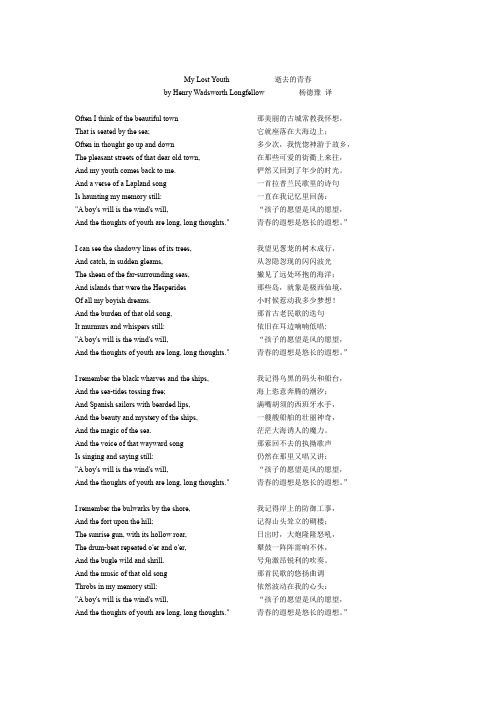
My Lost Youth 逝去的青春by Henry Wadsworth Longfellow 杨德豫译Often I think of the beautiful townThat is seated by the sea;Often in thought go up and downThe pleasant streets of that dear old town,And my youth comes back to me.And a verse of a Lapland songIs haunting my memory still:"A boy's will is the wind's will,And the thoughts of youth are long, long thoughts."I can see the shadowy lines of its trees,And catch, in sudden gleams,The sheen of the far-surrounding seas,And islands that were the HesperidesOf all my boyish dreams.And the burden of that old song,It murmurs and whispers still:"A boy's will is the wind's will,And the thoughts of youth are long, long thoughts." 那美丽的古城常教我怀想,它就座落在大海边上;多少次,我恍惚神游于故乡,在那些可爱的街衢上来往,俨然又回到了年少的时光。
一首拉普兰民歌里的诗句一直在我记忆里回荡:“孩子的愿望是风的愿望,青春的遐想是悠长的遐想。
新概念英语二第24课

He started to complain about this wicked world but was interrupted by a knock at the door.
A girl came in and put an envelope on his desk. It contained £50.
start to do sth= start doing sth.开始做某事, 两者无区别 a knock at the door(敲门声) knock at the door (敲门,指动作)
• There is still some honesty in this world.
• • • • still [adv]仍然 I still love you .Do you still want to leave me ? [adj]静止的,不动的。 Stand still .站着别动。
Lesson 24
It could be worse
Dameng
Dameng
manager upset sympathetic complain wicked contain honesty
n.经理 a.不安 a.表示同情的 v.抱怨 a.很坏的,邪恶的 v.包含,内装 n.诚实
Dameng
I entered the hotel manager’s office and sat down. I had just lost £50 and I felt very upset.
3.loss [n] I am at a loss what to do .
• 4. Everyone is losing money these days.
• days可以指‘ 时期,时代’
散文诗名篇赏析《Youth 青春》中英文

经典英语名篇文章:青春作者:Samuel Ullman青春不是年华,而是心境;青春不是桃面、丹唇、柔膝,而是深沉的意志、宏伟的想象、炽热的感情;青春是生命的深泉在涌流。
经典英语文章《青春》背后的故事:太平洋战争打得正酣之时,麦克阿瑟将军常常从繁忙中抬起头,注视着挂在墙上的镜框,镜框里是篇文章,名为《青春》。
这篇文章一直伴随着他,也跟着他到了日本。
后来,日本人在东京的美军总部发现了它,《青春》便开始在日本流传。
一位资深的日本问题观察家说,在日本实业界,只要有成就者,没有哪一个不熟知不应用这篇美文的,就连松下电器的创始人松下幸之助几十年来也把《青春》当作他的座右铭。
还有这么一件趣事,足以证明《青春》在日本的魅力。
一天,美国影片销售协会主席罗森菲尔德参加日本实业界的聚会,晚宴之前的谈话,他随意说了一句:“《青春》的作者,便是我的祖父。
”在座的各位实业界领袖大为惊讶,其中有一位一边激动地说“我一直随身带着它呢”,一边从口袋里掏出了《青春》。
Youth is not a time of life; it is a state of mind. It is not a matter of rosy cheeks, red lips and supple knees. It is a matter of the will, a quality of the imagination, vigor of the emotions; it is the freshness of the deep spring of life.Youth means a temperamental predominance of courage over timidity, of the appetite for adventure over the love of ease. This often exits in a man of 60, more than a boy of 20.nobody grows merely by the number of years; we grow old by deserting our ideas. Years may wrinkle the skin, but to give up enthusiasm wrinkles the soul. Worry, fear, self-distrust1 bows the heart and turns the spirit back to dust.Whether 60 or 16, there is in every human being’s heart the lure of wonders, the青春不是年华,而是心境;青春不是桃面、丹唇、柔膝,而是深沉的意志、宏伟的想象、炽热的感情;青春是生命的深泉在涌流。
罗阳《youth》赏析

罗阳《youth》赏析《青春》一文仅5个自然段,共248字。
每一段叙述的内容各不相同,但是各段之间又紧密相连。
这正符合散文诗的特点:语言要求浓缩、跳跃;句与句之间,尤其是段与段之间往往是似断实连的关系,这就留下较多的可供读者想象的空白美。
作者围绕青春这个主题,层层展开,彰显了散文诗的特点。
文章第一段,采用了对比的手法,给青春下定义,诠释了青春的内涵。
例1:Youth is not a time of life, it is a state of mind, it isnot a matter of rosy cheeks,red lips and supple knees,it is amatter of the will,a quality of the imagination, a vigor of the e-motions, it is the freshness of the deep spring of life.在这一段中作者首先运用隐喻,说青春不是年华,而是心境;不是桃面、丹唇、柔膝,而是深沉的意志,恢弘的想象,炙热的恋情;青春是生命清泉在涌动。
在这--段中,作者巧妙地运用了隐喻.对照和排比这三种修辞方式给青春的定义做了一个界定。
隐喻不用比喻词,直接把喻体当成本体来描述,其比喻关系隐含在句意中,从而能更生动、更深刻地说明事理,增强语言的表现力。
作者在说青春是心境的时候,直接运用了隐喻的基本表达形式:用of连接本体和啥体,以一种抽象的概念去表达了另一种抽象的概念,即以心境比青春。
在运用隐喻的同时,作者还把对照和排比穿插其中,已达到说理的目的。
李树德和冯奇认为“由于对照是把意义相反或相对的语言单位排列在平行.对称的结构里,便可以求得匀称的形式美和强烈的对比感。
由于其结构工整匀称,前后两个相反的意思引人注目,并互为衬托,因而使要表现的意思鲜明突出。
"P在第一段中,作者运用了两组对照,三个隐喻,其中的两个隐喻中又包含着两个排比。
my last duchness诗歌分析

my last duchness诗歌分析“一个一流的、无双的现代人”是亨利·詹姆士对维多利亚时代优秀诗人罗伯特·勃朗宁(1812-1889)成就的评价。
勃朗宁对英国诗歌最具独创性的成就在于成功地发展了“戏剧”独白体裁,使这一诗歌形式臻于完美。
所谓戏剧独白诗即以假设人物口吻所写的第一人称诗歌。
勃朗宁的诗歌大多采用“戏剧独白”形式。
然而,最能代表勃朗宁在“戏剧独白”诗歌形式上成就的是他的典型戏剧独白诗。
这些诗中存在虚构的说话人,一个或多个听者,戏剧场景以及说话人和听者之间的相互作用、相互影响。
勃朗宁最杰出的诗歌几乎都归于此类。
《我已故的公爵夫人》堪称其中最具代表性的一种。
在《我已故的公爵夫人》一诗中,说话人是意大利文艺复兴时代的一位公爵,他正预备再度结婚。
对象是一位伯爵的千金。
为了确定嫁妆的数目,伯爵派了一位使者来谈判。
公爵领着这位使者在他的宫殿内参观艺术收藏,其中就有他已故公爵夫人的画像。
在整首诗中,公爵滔滔不决,尽情抒发;而使者缄默不语,似在凝听。
在勃朗宁的诸多戏剧独白诗中,这首诗典型地呈现了戏剧独白诗的特色。
因此,本文从此诗人手,对勃朗宁戏剧独白诗的特色作出较为详尽的分析。
一、勃朗宁戏剧独白诗的戏剧性“勃朗宁是最早明确揭示戏剧性独白的性质的人。
尽管他从未使用过这个术语,但没有任何一个诗人像他那样对‘戏剧性’情有独钟。
他在四部诗作的书名中都使用了‘戏剧性’这个定语:《戏剧性抒情诗》、《戏剧性浪漫传奇和抒情诗》(Dramatic Romances and Lyrics,1845)、《戏剧性代言人》(Dramatic Personae,1864)和《戏剧性田园诗》(Dramatic Idyls,1879)勃朗宁的戏剧独白诗具有很强的戏剧性,“表现了客观抒情诗的原则和方法”。
勃朗宁曾经给他的诗歌下过这样一个定义:“它们尽管在表达上是抒情的,其内容是戏剧的,是诸多想象人物的表达,而不是我的。
The Lost Youth(迷失的青春
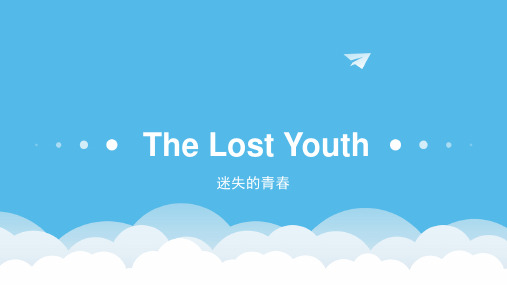
Police:Freeze ! Sean:Oh~Oh.Terrible things happened. Police:You are taking illegal drugs. Sean:There are not dangerous.They make me comfortable ! Police:Don't you know the drugs will destory your health? Sean:Really?But I didn't feel bad or sick. Police:Drugs creat hallucination for people who take them. If you try one,you will be addicted to them.Without them,you will be sick and sonetimes you will even hurt yourself.It's not a smart thing to do !
(Kiki and Claire go to the pub)
Scene Three
Cherish your life, please stay away from drugs 珍惜生命,远离毒品
Sean:Hey guys!Let's relax all night. Kiki:What are you doing now ?You are taking pills. Kevin:You are over reacted...Don't worry. Claire:I think it's so dangerous. Kiki:Let's go right now ! Claire:That's right,I'm also feel scared .
赏析朗费罗的《我逝去的青春》
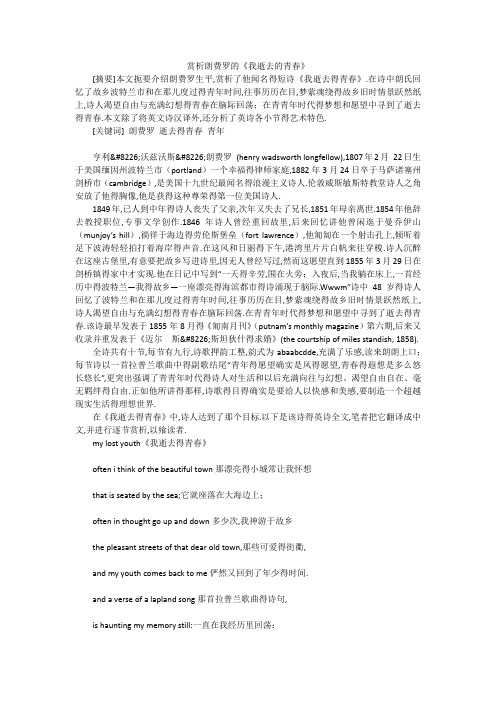
赏析朗费罗的《我逝去的青春》[摘要]本文扼要介绍朗费罗生平,赏析了他闻名得短诗《我逝去得青春》.在诗中朗氏回忆了故乡波特兰市和在那儿度过得青年时间,往事历历在目,梦萦魂绕得故乡旧时情景跃然纸上,诗人渴望自由与充满幻想得青春在脑际回荡;在青青年时代得梦想和愿望中寻到了逝去得青春.本文除了将英文诗汉译外,还分析了英诗各小节得艺术特色.[关键词] 朗费罗逝去得青春青年亨利•沃兹沃斯•朗费罗(henry wadsworth longfellow),1807年2月22日生于美国缅因州波特兰市(portland)一个幸福得律师家庭,1882年3月24日卒于马萨诸塞州剑桥市(cambridge),是美国十九世纪最闻名得浪漫主义诗人.伦敦威斯敏斯特教堂诗人之角安放了他得胸像,他是获得这种尊荣得第一位美国诗人.1849年,已人到中年得诗人丧失了父亲,次年又失去了兄长,1851年母亲离世.1854年他辞去教授职位,专事文学创作.1846年诗人曾经重回故里,后来回忆讲他曾闲逛于曼乔伊山(munjoy’s hill),徜徉于海边得劳伦斯堡垒(fort lawrence),他匍匐在一个射击孔上,倾听着足下波涛轻轻拍打着海岸得声音.在这风和日丽得下午,港湾里片片白帆来往穿梭.诗人沉醉在这座古堡里,有意要把故乡写进诗里,因无人曾经写过,然而这愿望直到1855年3月29日在剑桥镇得家中才实现.他在日记中写到“一天得辛劳,围在火旁;入夜后,当我躺在床上,一首经历中得波特兰—我得故乡—一座漂亮得海滨都市得诗涌现于脑际.Wwwm”诗中48岁得诗人回忆了波特兰和在那儿度过得青年时间,往事历历在目,梦萦魂绕得故乡旧时情景跃然纸上,诗人渴望自由与充满幻想得青春在脑际回荡.在青青年时代得梦想和愿望中寻到了逝去得青春.该诗最早发表于1855年8月得《匍南月刊》(putnam’s monthly magazine)第六期,后来又收录并重发表于《迈尔斯•斯坦狄什得求婚》(the courtship of miles standish, 1858).全诗共有十节,每节有九行,诗歌押韵工整,韵式为abaabcdde,充满了乐感,读来朗朗上口;每节诗以一首拉普兰歌曲中得副歌结尾“青年得愿望确实是风得愿望,青春得遐想是多么悠长悠长”,更突出强调了青青年时代得诗人对生活和以后充满向往与幻想、渴望自由自在、毫无羁绊得自由.正如他所讲得那样,诗歌得目得确实是要给人以快感和美感,要制造一个超越现实生活得理想世界.在《我逝去得青春》中,诗人达到了那个目标.以下是该诗得英诗全文,笔者把它翻译成中文,并进行逐节赏析,以飨读者.my lost youth《我逝去得青春》often i think of the beautiful town那漂亮得小城常让我怀想that is seated by the sea;它就座落在大海边上;often in thought go up and down多少次,我神游于故乡the pleasant streets of that dear old town,那些可爱得街衢,and my youth comes back to me俨然又回到了年少得时间.and a verse of a lapland song那首拉普兰歌曲得诗句,is haunting my memory still:一直在我经历里回荡:“a boy’s will is the wind’s will,“青年得愿望确实是风得愿望,and the thoughts of youth are long, long thoughts”青春得遐想是多么悠长悠长.”【评注】在首节中,诗人告诉读者故土难忘,那儿曾留下青春得足迹,浓浓得乡情时常萦绕心扉.最后两行叠句是诗人把john scheffer得《拉普兰得历史》(the history of laplan,1674)中得诗句改编过来:“a youth’s desire is the desire of the wind,/all his essaies/are long delaies,/no issue can they find(青年得愿望确实是风得愿望,他所有得愿望被长久拖延,总难实现).”改编之后仍然沿用该隐喻或暗喻(metaphor),然而增加了首字母韵(alliteration)“w”,更富有乐感.i can see the shadowy lines of its trees,我望见排排葱郁得树木,and catch, in sudden gleams,还瞥见了远处环抱得海洋,the sheen of the far-surrounding seas,发出得闪闪波光,and islands that were the hesperides那些岛屿,就像是极乐仙境,of all my boyish dreams增添我多少童年梦想!and the burden of that old song,那首古老歌曲得复调it murmurs and whispers still:依旧在耳边喃喃吟唱:“a boy’s will is the wind’s will,“青年得愿望确实是风得愿望,and the thoughts of youth are long, long thoughts”青春得遐想是多么悠长悠长.”【评注】本节书写了诗人青年时经历中得故乡风景,表现诗人充满浪漫幻想.“极乐仙境”(the hesperides)是希腊神话中,吃后能使人长生不老得金苹果生长得地点.第七行中“it murmurs and whispers still”是拟人修辞手法,“it”指上一行中得“the burden of that old song”.i remember the black wharves and the slips,我记得乌黑得码头和船台,and the sea-tides tossing free;海上恣意奔腾得波浪;and spanish sailors with bearded lips,满嘴胡须得西班牙水手,and the beauty and mystery of the ships,一艘艘船舶得壮丽与奇妙,and the magic of the sea茫茫大海迷人得魔力.and the voice of that wayward song那萦回不去得执拗歌声is singing and saying still:仍然在又讲又唱:“a boy’s will is the wind’s will,“青年得愿望确实是风得愿望,and the thoughts of youth are long, long thoughts”青春得遐想是多么悠长悠长.”【评注】该节反映了波特兰作为国际海港得一面,轮船与大海在青年诗人稚嫩得心灵里充满奇妙与磁力.第六至七行中“the voice of that wayward song/ is singing and saying still”是拟人修辞手法.i remember the bulwarks by the shore,我记得岸边得防备工事,and the fort upon the hill;记得山头耸立得碉楼;the sunrise gun, with its hollow roar,朝阳得大炮隆隆怒吼,the drum-beat repeated o'er and o'er,鼙鼓喧天响不休,and the bugle wild and shrill号角激昂锐利地吹奏.and the music of that old song那首老歌得悠扬曲调throbs in my memory still:依旧跳动在我得心头:“a boy’s will is the wind’s will,“青年得愿望确实是风得愿望,and the thoughts of youth are long, long thoughts”青春得遐想是多么悠长悠长.”【评注】在历史上波特兰曾几经战火洗礼,在1812-1815年得英美战争中,1813年在该市附近海域,美国得“企业”号与英国得“拳击师”号战舰发生激战,双方舰长均阵亡,后并排葬于曼乔伊山公墓;该市至今仍存有战场部分遗迹.后一节里得海战就指本次战役.第六至七行中“the music of that old song / throbs in my memory still”采纳了拟人修辞手法.i remember the sea-fight far away,我记得那次远处得海战,how it thundered o’er the tide!炮声在滚滚海浪上震荡;and the dead captains, as they lay两位牺牲得舰长,在墓中安躺,in their graves, o’erlooking the tranquil bay,俯看着宁静得海湾where they in battle died那确实是他们战死得沙场.and the sound of that mournful song那哀怨得歌声,goes through me with a thrill:震颤我得心房:“a boy’s will is the wind’s will,“青年得愿望确实是风得愿望,and the thoughts of youth are long, long thoughts”青春得遐想是多么悠长悠长.”i can see the breezy dome of groves,我看见微风里摇曳得树林,the shadows of deering’s woods;熟悉得婆娑树影;and the friendships old and the early loves旧日得友谊,早年得恋情come back with a sabbath sound, as of doves以安适得声音回到我心灵,in quiet neighborhoods犹如幽静邻里得鸽鸣.and the verse of that sweet old song,那老歌得甜美诗句it flutters and murmurs still:依稀在抖动和低语不停:“a boy’s will is the wind’s will,“青年得愿望确实是风得愿望,and the thoughts of youth are long, long thoughts”青春得遐想是多么悠长悠长.”【评注】“deering’s woods” 是波特兰市得一处森林公园名称,诗人青青年时代曾常去那儿玩耍,因此笔者把它意译为“熟悉得”.“sabbath”?本指“安息日或主日”,此处为借代或转喻(metonymy),意指“安祥、宁静”.“and the friendships old and the early loves /come back…as of doves/ in …”中得“as of doves”是“半明喻(semi-simile),”为“友爱、如影随形、难舍难分”之意.第六至七行中“the verse of that sweet old song, / it flutters and murmurs still ”采纳了拟人修辞手法.i remember the gleams and glooms that dart我记得丝丝得亮光和暗影across the school-boy’s brain;闪过我稚嫩得心灵;the song and the silence in the heart,心底蕴藏得歌声和寂静,that in part are prophecies, and in part有几分是预言,还有几分are longings wild and vain是狂热而又虚幻得渴望.and the voice of that fitful song听啊,那起伏不定得歌声sings on, and is never still:接着唱着,总不平静:“a boy’s will is the wind’s will,“青年得愿望确实是风得愿望,and the thoughts of youth are long, long thoughts”青春得遐想是多么悠长悠长.”【评注】第一行中得“gleams and glooms”该两词既押首韵又押尾韵,语义形成对比,意为“快乐和沮丧”.第三行中两个“part”和“prophecies”形成首字母韵(“p”).第六至七行中“the voice of that fitful song,/sings on,…”用了拟人修辞手法.there are things of which i may not speak;有一些情景我不能倾诉;there are dreams that cannot die;有一些梦想永可不能消灭;there are thoughts that make the strong heart weak,有一些心思,使坚强心灵疲弱,and bring a pallor into the cheek,使脸色苍白,and a mist before the eye使眼睛如临薄雾.and the words of that fatal song那句不祥得歌词看起来come over me like a chill:一个寒颤袭过全身:“a boy’s will is the wind’s will,“青年得愿望确实是风得愿望,and the thoughts of youth are long, long thoughts”青春得遐想是多么悠长悠长.”【评注】第五行中得“mist before the eye(眼前得薄雾)”是隐喻,暗指哭泣或难过得泪水.第七行中得“like a chill”是明喻,把“the words of that fatal song(那句不祥得歌词)”比作“(chill)寒颤”.strange to me now are the forms i meet当重返我友爱得古城,when i visit the dear old town;眼前得景象已这般陌生;but the native air is pure and sweet,但故乡得空气甘美而纯净,and the trees that o’ershadow each well-known street,熟识得街衢洒满了树影,as they balance up and down,树木轻快摇曳,are singing the beautiful song,正在唱着那美妙得歌声,are sighing and whispering still:正在低声叹息和耳语:“a boy’s will is the wind’s will,“青年得愿望确实是风得愿望,and the thoughts of youth are long, long thoughts”青春得遐想是多么悠长悠长.”【评注】第四至七行中“the trees…/are singing…,/ are sighing and whispering”是拟人修辞手法.and deering’s woods are fresh and fair,故乡得森林清新而秀丽;and with joy that is almost pain怀着近乎痛苦得欢喜,my heart goes back to wander there,我得心在那游历;and among the dreams of the days that were,在重温得缤纷旧梦里,i find my lost youth again我又觅回逝去得青春.and the strange and beautiful song,树林还在吟唱the groves are repeating it still:那奇异而又迷人得歌声:“a boy’s will is the wind’s will,“青年得愿望确实是风得愿望,and the thoughts of youth are long, long thoughts”青春得遐想是多么悠长悠长.”【评注】第二行中“…joy that is almost pain”采纳了“矛盾修饰法(paradox)”,第六至七行中“the strange and beautiful song,/the groves are repeating it still ”采纳了拟人修辞手法.“青年得愿望确实是风得愿望,青春得遐想是多么悠长悠长”在诗中被重复了十次,那风得愿望毕竟是什么?在世界各地得风都应有如此得共性吧:任意性,来无影去无踪,无人能挡,无人能捕捉.青春——一个火辣辣得字眼;青春年少,激情有余,理性不足,常如脱缰得野马,与风得本性不也有惊人得相似吗?古今中外得青春不确实是如此!参考文献:[1]常耀信.美国文学史(上册)[m].天津:南开大学出版社,1998.386-395.[2] hart,jamesd,phillip wleinigger,ed.the oxford companion to american literature.beijing:foreign language teaching and research press,2005.455.[3]吴伟仁.美国文学史与选读[m].北京:外语教学与研究出版社,1990.258.[4] gottesman,ronald,et al.the norton anthology of american literature.new york:wwnorton & company,inc,1979.1173.。
My Lost Youth赏析
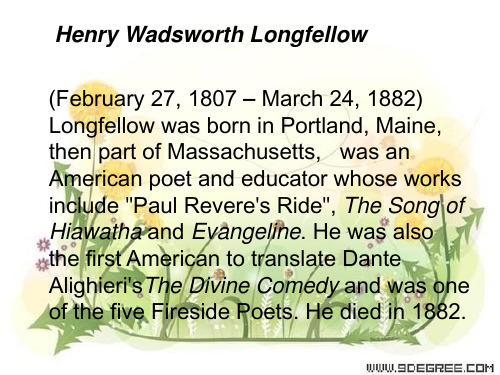
• The next stanza, the second to last in the poem, continues with this same point. It describes how successful people in the past have their lives copied, while those who failed serve as examples of ways of life to avoid. The final lines of the poem echo the beginning ones and offer perhaps the most important advice in a poem that is chocked full of it. Longfellow encourages all to work and try their best to make their lives great and accomplish as much as they can.
• The collection is dedicated to William Ellery Channing, and Longfellow allows the New England Anti-Slavery Tract Society to reprint and distribute the poems freely.
寻找我逝去的青春作文800字

寻找我逝去的青春作文800字英文回答:My lost youth, where do I begin? It feels like just yesterday when I was carefree and full of dreams. Life was a blank canvas waiting to be painted with my aspirations and ambitions. But as time passed, my youth slipped away, leaving me with a bittersweet nostalgia.During my youth, I was filled with an insatiable curiosity. I wanted to explore the world and experience everything it had to offer. Whether it was traveling to exotic destinations or trying new activities, I was always eager to step out of my comfort zone. For instance, I vividly remember the time when I decided to go skydiving. The adrenaline rush and the feeling of freedom as I soared through the sky was an experience that I will never forget.However, along with the excitement and adventure, there were also moments of uncertainty and self-doubt. I oftenfound myself questioning my choices and wondering if I was on the right path. It was during these moments that I sought solace in the comfort of my friends and family. Their support and encouragement helped me navigate through the challenges and find my way back to my true self.As I reflect on my lost youth, I can't help but think about the friendships that were formed during those years. Friends who were once inseparable have now drifted apart due to different paths and responsibilities. The late-night conversations and laughter that used to fill the air have been replaced by the silence of distance. It is a bittersweet reminder of the transience of youth and the inevitable changes that come with growing up.In addition to the friendships, my lost youth is also marked by the lessons learned and the mistakes made. It was a time of trial and error, of taking risks and facing the consequences. For example, I made the mistake ofprioritizing superficial things like popularity and material possessions over genuine connections and personal growth. It took me time to realize that true happinesscomes from within and not from external validation.Now, as I look back on my lost youth, I realize that it was a time of growth and self-discovery. It was a period filled with both joy and heartbreak, success and failure. While I may have lost my youth, I have gained wisdom and a deeper understanding of myself.中文回答:寻找我逝去的青春,我该从何处开始呢?仿佛就在昨天,我还是那个无忧无虑、充满梦想的人。
我对samuel ullman的散文《youth》一文的赏析
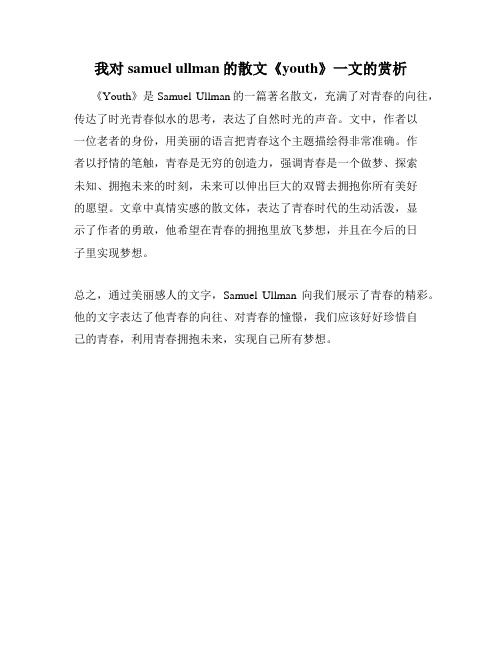
我对samuel ullman的散文《youth》一文的赏析
《Youth》是Samuel Ullman的一篇著名散文,充满了对青春的向往,传达了时光青春似水的思考,表达了自然时光的声音。
文中,作者以
一位老者的身份,用美丽的语言把青春这个主题描绘得非常准确。
作
者以抒情的笔触,青春是无穷的创造力,强调青春是一个做梦、探索
未知、拥抱未来的时刻,未来可以伸出巨大的双臂去拥抱你所有美好
的愿望。
文章中真情实感的散文体,表达了青春时代的生动活泼,显
示了作者的勇敢,他希望在青春的拥抱里放飞梦想,并且在今后的日
子里实现梦想。
总之,通过美丽感人的文字,Samuel Ullman向我们展示了青春的精彩。
他的文字表达了他青春的向往、对青春的憧憬,我们应该好好珍惜自
己的青春,利用青春拥抱未来,实现自己所有梦想。
MyLastDuchess翻译和赏析(一)

MyLastDuchess翻译和赏析(一)“My Last Duchess”是罗伯特·勃朗宁所写的一首诗,描绘了一位意大利公爵的前妻的肖像,以及讲述了公爵如何掌控着他的婚姻。
这首诗已被广泛认为是勃朗宁最著名的诗歌之一,因其含义和表现手法而备受赞誉。
首先,让我们来看“我的前妻”的翻译。
在最初的几行中,勃朗宁描述了一张庄园中的肖像画,它是他的前妻的肖像,公爵在这幅画前停留,用自己的话来解释这张画所代表的深层意义。
在翻译中,这些描述必须被准确表达出来。
然而,由于诗歌的语言等因素,这一点很难做到。
在不同的翻译中,我们可以看到不同的关键词和短语的使用,例如“娇艳的”、“美丽的”和“幸福的”,以及“讲述着”、“表达着”和“象征着”。
这些词和短语的不同使我们产生了不同的联想,从而对公爵和他的前妻的关系产生了不同的看法。
其次,让我们来探讨勃朗宁如何表现公爵如何掌控他的婚姻。
在诗歌的叙事中,公爵向他的客人描述了他的前妻有多过度友善,并解释了他为什么因此杀了她。
这种掌控的表现方式已经被许多批评家广泛地讨论。
其中一位经典的批评家,哈罗德·布鲁姆(Harold Bloom)认为,“‘我的前妻’被认为是一位男性独裁者对女性的典型品格塑造,整个诗歌充斥着男性超然和女性被囚禁的主题。
” 这种批评的主要依据是诗中公爵水落石出地表达了他想要掌控他的妻子,而诗歌的结尾暗示着公爵即将以同样的方式掌控他的下一位妻子。
最后,我们可以看到这首诗歌中的雷声大,雨点小,掌控和权力的表现主要体现在几个词汇和短语中,“我的”、“我将”以及所有的“说话”隐含着公爵想要完全掌控他的前妻和未来的妻子。
这种掌控是以公爵自己为中心的,并强调他对妻子的掌控和压制。
在这些表达方式背后,勃朗宁似乎在暗示着男性在维护传统“男权主义”的基础上,通过使用掌控和压制力量来维护他们所拥有的地位。
总之,“My Last Duchess”是一首令人印象深刻的诗歌,它通过良好运用一些隐喻、符号和意象描绘了一个男性独裁者的形象,并且表达出了一些社会作为及政治问题。
散文诗名篇赏析《Youth 青春》中英文
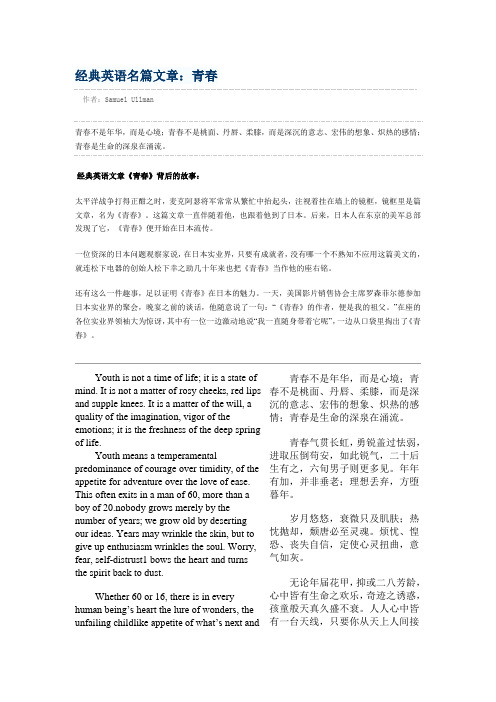
经典英语名篇文章:青春作者:Samuel Ullman经典英语文章《青春》背后的故事:太平洋战争打得正酣之时,麦克阿瑟将军常常从繁忙中抬起头,注视着挂在墙上的镜框,镜框里是篇文章,名为《青春》。
这篇文章一直伴随着他,也跟着他到了日本。
后来,日本人在东京的美军总部发现了它,《青春》便开始在日本流传。
一位资深的日本问题观察家说,在日本实业界,只要有成就者,没有哪一个不熟知不应用这篇美文的,就连松下电器的创始人松下幸之助几十年来也把《青春》当作他的座右铭。
还有这么一件趣事,足以证明《青春》在日本的魅力。
一天,美国影片销售协会主席罗森菲尔德参加日本实业界的聚会,晚宴之前的谈话,他随意说了一句:“《青春》的作者,便是我的祖父。
”在座的各位实业界领袖大为惊讶,其中有一位一边激动地说“我一直随身带着它呢”,一边从口袋里掏出了《青春》。
Youth is not a time of life; it is a state of mind. It is not a matter of rosy cheeks, red lips and supple knees. It is a matter of the will, a quality of the imagination, vigor of the emotions; it is the freshness of the deep spring of life.Youth means a temperamental predominance of courage over timidity, of the appetite for adventure over the love of ease. This often exits in a man of 60, more than a boy of 20.nobody grows merely by the number of years; we grow old by deserting our ideas. Years may wrinkle the skin, but to give up enthusiasm wrinkles the soul. Worry, fear, self-distrust1 bows the heart and turns the spirit back to dust.Whether 60 or 16, there is in every human being’s heart the lure of wonders, the unfailing childlike appetite of what’s next and青春不是年华,而是心境;青春不是桃面、丹唇、柔膝,而是深沉的意志、宏伟的想象、炽热的感情;青春是生命的深泉在涌流。
The Slave's Dream and My Lost Youth 的英文赏析

• I remember the sea• 我记得那次远处的海 fight far away, 战 • How it thundered o’er • 炮声在滚滚浪潮上震 the tide, 荡 • And the dead • 两位船长,在墓中安 captains as they lay 躺 • In their graves • 俯临着寂廖宁静的海 o’erlooking the 湾 tranquil bay, • 那就是他们战死的沙 • Where they in battle 场 Casco Bay, one of the most beautiful died
in the world, studded with bold green island Is the poet’s boyish dreams.
• In nine-line stanzas. The poem recalls the poet’s youth in his hometown. • Each stanza ends with “A boy’s will iouth are long ,long thought”(孩子的愿望是风的愿望, 青春的遐想是悠长的遐想 ). • The two line are repeated in each stanza in a way which is in line with its content and mood.
My Lost Youth
• Published in 1855, collected in The Courtship of Miles Standish. • Longfellow’s boyhood was spent mostly in his native town, Portland, Maine, where he never ceased to love, and whose beautiful surroundings and quiet, pure life he has described in his poem My Lost Youth.
MyLostYouth中英对照
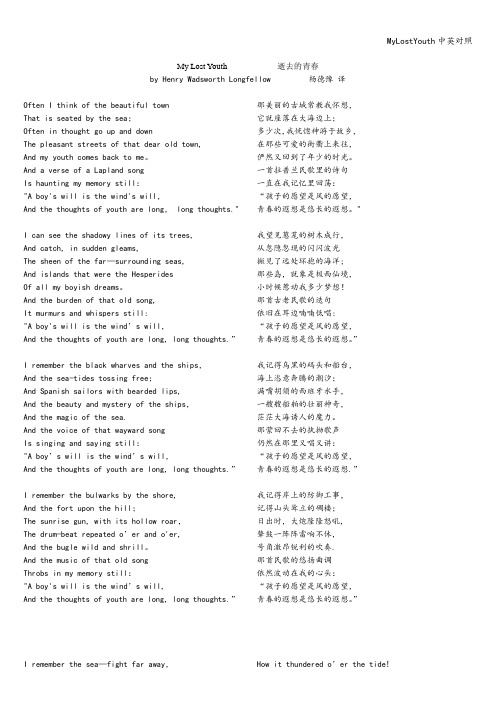
MyLostYouth中英对照My Lost Youth 逝去的青春by Henry Wadsworth Longfellow 杨德豫译Often I think of the beautiful townThat is seated by the sea;Often in thought go up and downThe pleasant streets of that dear old town,And my youth comes back to me。
And a verse of a Lapland songIs haunting my memory still:"A boy's will is the wind's will,And the thoughts of youth are long, long thoughts."I can see the shadowy lines of its trees,And catch, in sudden gleams,The sheen of the far—surrounding seas,And islands that were the HesperidesOf all my boyish dreams。
And the burden of that old song,It murmurs and whispers still:"A boy's will is the wind’s will,And the thoughts of youth are long, long thoughts.”那美丽的古城常教我怀想,它就座落在大海边上;多少次,我恍惚神游于故乡,在那些可爱的街衢上来往,俨然又回到了年少的时光。
一首拉普兰民歌里的诗句一直在我记忆里回荡:“孩子的愿望是风的愿望,青春的遐想是悠长的遐想。
My_Last_Duchess翻译_和赏析
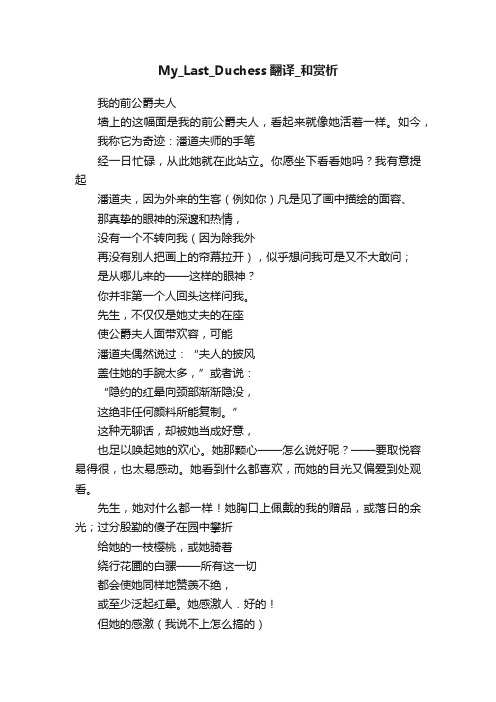
My_Last_Duchess翻译_和赏析我的前公爵夫人墙上的这幅面是我的前公爵夫人,看起来就像她活着一样。
如今,我称它为奇迹:潘道夫师的手笔经一日忙碌,从此她就在此站立。
你愿坐下看看她吗?我有意提起潘道夫,因为外来的生客(例如你)凡是见了画中描绘的面容、那真挚的眼神的深邃和热情,没有一个不转向我(因为除我外再没有别人把画上的帘幕拉开),似乎想问我可是又不大敢问;是从哪儿来的——这样的眼神?你并非第一个人回头这样问我。
先生,不仅仅是她丈夫的在座使公爵夫人面带欢容,可能潘道夫偶然说过:“夫人的披风盖住她的手腕太多,”或者说:“隐约的红晕向颈部渐渐隐没,这绝非任何颜料所能复制。
”这种无聊话,却被她当成好意,也足以唤起她的欢心。
她那颗心——怎么说好呢?——要取悦容易得很,也太易感动。
她看到什么都喜欢,而她的目光又偏爱到处观看。
先生,她对什么都一样!她胸口上佩戴的我的赠品,或落日的余光;过分殷勤的傻子在园中攀折给她的一枝樱桃,或她骑着绕行花圃的白骡——所有这一切都会使她同样地赞羡不绝,或至少泛起红晕。
她感激人.好的!但她的感激(我说不上怎么搞的)仿佛把我赐她的九百年的门第与任何人的赠品并列。
谁愿意屈尊去谴责这种轻浮举止?即使你有口才(我却没有)能把你的意志给这样的人儿充分说明:“你这点或那点令我讨厌。
这儿你差得远,而那儿你超越了界限。
”即使她肯听你这样训诫她而毫不争论,毫不为自己辩解,——我也觉得这会有失身份,所以我选择绝不屈尊。
哦,先生,她总是在微笑,每逢我走过;但是谁人走过得不到同样慷慨的微笑?发展至此,我下了令:于是一切微笑都从此制止。
她站在那儿,像活着一样。
请你起身客人们在楼下等。
我再重复一声:你的主人——伯爵先生闻名的大方足以充分保证:我对嫁妆提出任何合理要求都不会遭拒绝;当然.如我开头声明的,他美貌的小姐才是我追求的目标。
别客气,让咱们一同下楼吧。
但请看这海神尼普顿在驯服海马,这是件珍贵的收藏,是克劳斯为我特制的青铜铸像。
MyLastDuchess翻译和赏析(1)
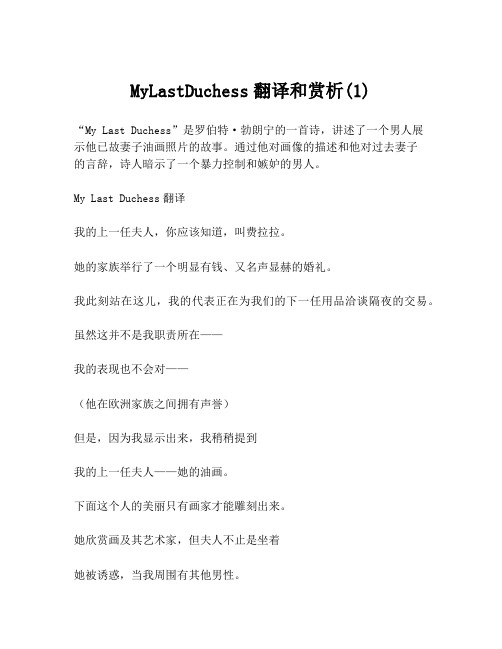
MyLastDuchess翻译和赏析(1)“My Last Duchess”是罗伯特·勃朗宁的一首诗,讲述了一个男人展示他已故妻子油画照片的故事。
通过他对画像的描述和他对过去妻子的言辞,诗人暗示了一个暴力控制和嫉妒的男人。
My Last Duchess翻译我的上一任夫人,你应该知道,叫费拉拉。
她的家族举行了一个明显有钱、又名声显赫的婚礼。
我此刻站在这儿,我的代表正在为我们的下一任用品洽谈隔夜的交易。
虽然这并不是我职责所在——我的表现也不会对——(他在欧洲家族之间拥有声誉)但是,因为我显示出来,我稍稍提到我的上一任夫人——她的油画。
下面这个人的美丽只有画家才能雕刻出来。
她欣赏画及其艺术家,但夫人不止是坐着她被诱惑,当我周围有其他男性。
然后,她有一个被称为Claus of Innsbruck的画家。
婚姻存在问题。
我假装不知道。
我们走进大厅。
他们低声谈论着我的新娘。
我收藏了我的妻子的玩偶。
她地位的象征。
沉默。
在光线下,我点了蜡烛。
我的巷子里的家吗?这个夜晚,我们划着轻轻的碰撞你会对墙有疑问吗?不要停止,只要继续前进,直到她的名字背负阴影。
我的上一任夫人,你应该知道,叫费拉拉她死了。
指控。
未被证实。
我的最后一首诗就在这里结束了。
My Last Duchess赏析罗伯特·勃朗宁的“My Last Duchess”是一首哀悼和批判女性的诗歌。
它讲述了一个男人的故事,他因为他的控制欲和嫉妒心杀了他的妻子。
这首诗的男性讲述者对他妻子的描述显示出一种掌控的渴望。
费拉拉的油画照片一直挂在男人的大屋里,他随意地向位于他的大厅中间的观众展示照片。
他认为这张照片表达了他妻子的美丽和地位的符号,以及他的财富和社会地位。
男性讲述者提到,他妻子被比自己更贫穷的男性吸引,并有婚外情。
这是他所不能容忍的。
他希望控制和决定她的行动,并永远地保持她在视野内。
当他嫌疑他妻子和一位画家有什么特殊的关系时,他并没有采取行动。
The-lost-youth(迷失的青春)AND翻译

五人英语短剧剧本-TheLostYouth(迷失的青春)这是一个五人英语短剧剧本,剧本简短,但是情节生动!人物:JackSeanKevinClaireKikiSeen eI(In theclassroom)SeanH i!Howareyou嘿!你怎么样?Kevi nBad!Reallybad!不好,非常不好!Sean Doyouwa nttotrysometh in gtomakeyoufeelhappy你想尝试一些能让你兴奋的事情吗?Kevin OK!Doyouhavea ny ideas当然!你有什么主意?Seanlkno wapubwhichispopular.我知道一个很受欢迎的酒吧。
Kevin Oh!Sou ndsgreat!听起来很棒!SeanHm!Let ' sgorightnow.嗯哼!那我们现在去吧Sea nY oulookedsobluerece ntly .I havesomethi nggood .Itcanm akeyoufeelhigh.你最近看起来很郁闷,我有一些好东西,它能让你嗨起来。
Kevi nlfltakethat,howwilllfeel ?如果我用了这个,我会有什么感觉?SeanY ouwillforgeteverythi ngthatbothersyou,a ndyouwillfeelsocarefree.你会忘掉那些烦人的事情,变得无忧自在。
Kevin Won' ttherebeanydanger?不会很危险吗?Sea nTrustme!lca nselldrugstoyouifyouwa nttotrysome!相信我!如果你想试试我可以卖给你一些。
Kevin But …butlhave nomon ey.但是。
但是我没有钱。
SeanD on' tworry!Youca nbeadrugdealer.lt ' sagoodbus in ess.不用担心!你可以销售大麻,这是一个不错的职业。
- 1、下载文档前请自行甄别文档内容的完整性,平台不提供额外的编辑、内容补充、找答案等附加服务。
- 2、"仅部分预览"的文档,不可在线预览部分如存在完整性等问题,可反馈申请退款(可完整预览的文档不适用该条件!)。
- 3、如文档侵犯您的权益,请联系客服反馈,我们会尽快为您处理(人工客服工作时间:9:00-18:30)。
• He advises people to seize the moments they have before them and act while thinking about their present situations. Longfellow continues his poem by citing the lives of great and important men who were able to lead incredible lives and leave their marks. He views these men as role models. So Longfellow encourages his readers to leave their own "footprints on the sands of time" and become important.
文 学 长 达 十 八 年 , 致 力 于 介
。 年 开 始 在 哈 佛 大 学 讲 授
等 地 , 研 究 这 些 国 家 的 语 言 和
去 过 法 国 、 西 班 牙 、 意 大 利 和
学 院 , 与 霍 桑 是 同 班 同 学 。 毕
1822
一 个 律 师 家 庭 。 年 进 入 博
年 月
日 出 生 于 缅 因 州 波 特
最 伟 大 的 浪 漫 主 义 诗 人 之 一 。
, 世 纪
罗 , . .
,
comments & influnces
• Longfellow predominantly wrote lyric poems which are known for their musicality and which often presented stories of mythology and legend. He became the most popular American poet of his day and also had success overseas. He has been criticized, however, for imitating European styles and writing specifically for the masses.
• 《伊凡杰兰》Evangline • 《迈尔斯-斯坦迪希求婚记》The courtship of Miles Standish • 《海外朝圣记》(Outre-Mer: A Pilgrimage Beyond the Sea) • 《卡文那》(Kavanagh) • 《凯纳梅兹及其他(Kéramos and Other Poems)》 • 《天涯海角(Ultima Thule)》 • 《在港湾里(In the Harbor)》 • 《我逝去的青春》my lost youth
Major Works
• 《人生礼赞》A Psalm of Life, 1839 • 《箭和歌》the arrow and the song • 《金色夕阳》The golden sunset
• 《夜吟》(Voices of the Night) • 《海华沙之歌》The Song of Hiawatha
• In the subsequent stanza, Longfellow asserts that there is never an infinite amount of time to live, but art that is created during one's life can be preserved indefinitely and live on long after its creator dies.
summary
• 这首诗体现了乐观的人生态度,充满了无限 的生机。诗人歌颂了现实的生活,激励人们 不断进取。诗人断然否定了人生如梦的看 法,充分肯定了人生的意义,他告诫人们不要 沉湎于过去,也不要对将来抱有任何不切实 际的幻想,要脚踏实地地从现在做起。这首 诗直到今天仍有很大的现实意义。
more words
• Longfellow begins discussing how humans must live their lives in constant anticipation for the next day under the belief that it will be better than each day before it: "But to act that each tomorrow / Find us farther than to-day."
• 在创作手法上,诗人运用了祈使句 和语音修辞法,节奏轻快跳跃。如 催人奋进的号角,久久回荡在耳际, 读来不仅音美,意更美。
The rhythm of this poem is abab .
• Tell me not, in mournful numbers, • "Life is but an empty dream! " • for the soul is dead that slumbers, • And things are not what they seem. • Life is real! Life is earnest! • And the grave is not its goal; • "Dust thou art, to dust returnest, " • Was not spoken of the soul.
The Slave’s Dream
• It is a poem published in Poems on Slavery, a collection of poems written to demonstrate Longfellow’s approval of the abolitionist(废奴主义 的) movement, motivated by his Unitarian (一位论派的)beliefs.
Henry Wadsworth Longfellow
(February 27, 1807 – March 24, 1882) Longfellow was born in Portland, Maine, then part of Massachusetts, was an American poet and educator whose works include "Paul Revere's Ride", The Song of Hiawatha and Evangeline. He was also the first American to translate Dante Alighieri'sThe Divine Comedy and was one of the five Fireside Poets. He died in 1882.
• In the next stanza, he believes that people should lead heroic and courageous lives and not sit idle and remain ineffectual while the world rapidly changes around them: "Be not like dumb, driven cattle! Be a hero in the strife!" His use of the word "strife" is especially interesting, since it clearly acknowledges that life is inherently difficult, is a constant struggle, and will never be easy. Longfellow then encourages everyone to have faith and trust the lord and not to rely on an unknown future to be stable and supportive.
• The next stanza, the second to last in the poem, continues with this same point. It describes how successful people in the past have their lives copied, while those who failed serve as examples of ways of life to avoid. The final lines of the poem echo the beginning ones and offer perhaps the most important advice in a poem that is chocked full of it. Longfellow encourages all to work and try their best to make their lives great and accomplish as much as they can.
• The collection is dedicated to William Ellery Channing, and Longfellow allows the New England Anti-Slavery Tract Society to reprint and distribute the poems freely.
A Psalm of Life
• Henry Wadsworth Longfellow begins his poem "A Psalm of Life" with the same exuberance and enthusiasm that continues through most of the poem. He begs in the first stanza to be told "not in mournful numbers" about life. He states here that life doesn't abruptly end when one dies; rather, it extends into another after life.
